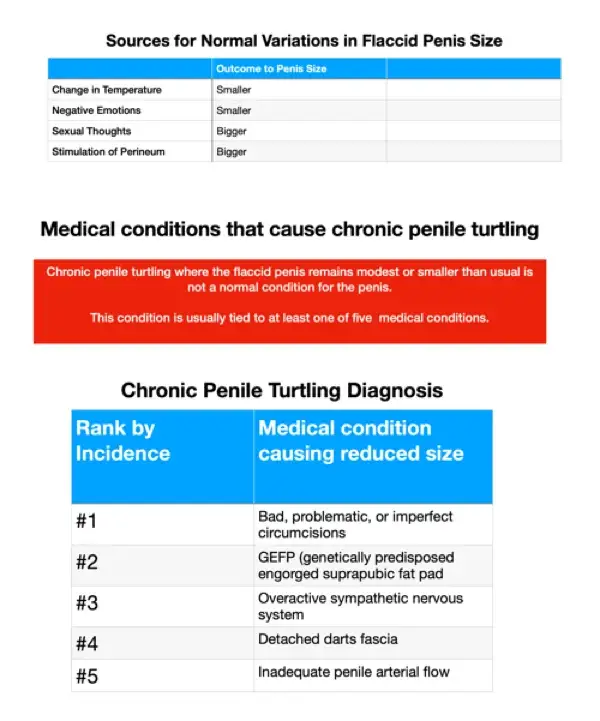“How’s it hanging?”
This common cliché, which alludes directly to the flaccid size of a man’s penis, is a metaphor for how well a man is doing in his life. In other words, it is a reminder of the importance of flaccid size to a man’s happiness.
However, medical research only defines “penile turtling” as diseases in which the underlying penis organ shrinks in size as a result of healthcare conditions like as aging, Peyronie’s disease, obesity, and prostate surgery.
Obviously, there’s a big disconnect between what doctors are describing as “turtling” and what 99 percent of men define as “turtling.”
This clinical report bridges this medical disparity by discussing underlying causes of why a penis varies in length and thickness when at rest, including medical conditions that cause chronic turtling, and how to diagnose and fix each of those diagnoses. Men are often seeking turtling repair or a cure. This article will detail all the causes and treatment options. Ask the Rejuvall team a question about repair techniques and options.

What is turtling syndrome?
What is penis turtling?
The term “turtling” is a metaphorical reference to when a penile shaft visibly contracts when flaccid to resemble the appearance of a turtle, with the glans (head) resembling the turtle’s head and the scrotum resembling the turtle’s outer shell. It is a depressing physiological state for nearly all men who routinely turtle.
Let’s face it: a man’s penis is often referred to as his “manhood” for a reason. Every guy wants to display his biggest size, especially in front of others.

How does an erection occur?
Before we discuss why a penis gets smaller, let’s first review how it becomes its largest, which is during an erection. Some of the fundamental inputs that make it bigger are also linked to what causes it to shrink, just in reverse.
Consider an erection you had when you were 15 years old, when the entire process worked flawlessly.
Every erection starts in the brain. It begins with a neurologic trigger from a sexual stimulus. For instance, we think of something, see something, hear something, touch someone, or are touched by someone else. This stimulus sends a signal to the body to immediately pump blood into the two thick “sponges” (known as the corpus cavernosum), which are the fundamental internal component of an erection. While blood is being pumped into the penis, the outer edges of the sponge expand to enable the maximum amount of blood to fill the penis. When the corpora are completely filled with blood, the organ self-seals, locking the blood in place until the brain sends another message to release it, which happens after we experience orgasm or a strong emotion such as fear (i.e., someone enters the room unexpectedly).
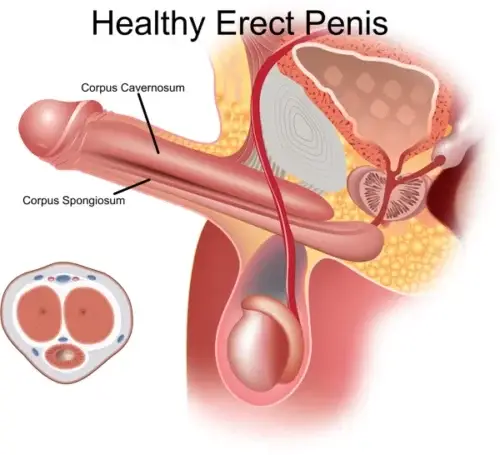
What causes a flaccid penis to change in length & thickness during each day?

The medical purpose behind an erect, fully engorged penis is so that it can effectively penetrate the vagina during sexual activity.
When we are not sexually aroused, the body retains significantly less blood in the organ, a condition known as our “flaccid state.” The penis spends the majority of its existence flaccid, soft, or “at rest.” However, every day, the length and girth of a man’s flaccid penis vary in exact measurements.
Although the precise list of medical causes for these changes is too long for this encapsulation, we will summarize the top four sources for its daily size fluctuations.
1. A Change in Temperature
Warmth activates a neural response that relaxes the penile dartos and cremaster muscles, allowing the penis to rest in its optimally flaccid state. Conversely, the penis and testicles are drawn inward by a contraction of the penile dartos and cremaster muscles.
The dartos fascia muscle is located just above the penis and inside the shaft, whereas the cremaster muscle is located under the epidermis along the inner shaft and extends downward into the scrotum, where it wraps around the testes. The reason men turtle when swimming in a pool is because the dartos and cremaster muscles tighten from the groin area’s direct contact with cooler water.
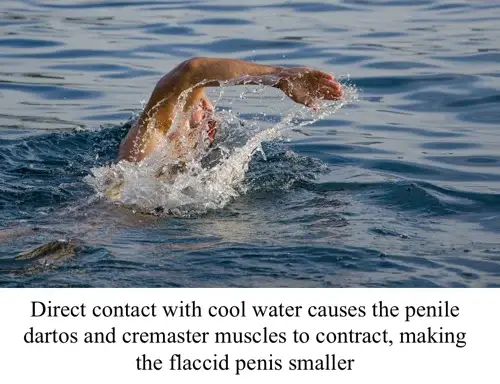
2. Negative Emotions

Men’s dartos fascia and penile cremaster muscles are activated by sympathetic nerve responses1. If we experience stress, anxiety, embarrassment or fear, we unconsciously send a message for the dartos muscle to retract the penis and the cremaster muscles to contract the scrotum. Men who suffer from constant stress sometimes overwork their cremaster muscles to the point of causing testicular pain.
Resonating pain from a chronic injury like in the spine is a common mechanism to trigger a sympathetic nerve response and cause the dartos and cremaster muscles to tighten and cause turtling.
[1] British Journal of Urology, 2002 Aug; 136(8): 1194–1200.
3. Stimulation of the Perineum
On the other end of the spectrum, there’s natural conditions that make our flaccid size larger. Your perineum is the small area of delicate tissue between your scrotum and your anus. The average length of a man’s perineum is roughly two inches. Multiple layers of connective tissue, fatty tissue, muscles, and membranes lie beneath the perineal epidermis. The pudendal nerve passes through the perineum and branches into the penis. Any stimulation of the perineum, will usually trigger an increase in flaccid size. Some men notice such a change just after a bowel movement, which can arouse the perineum.
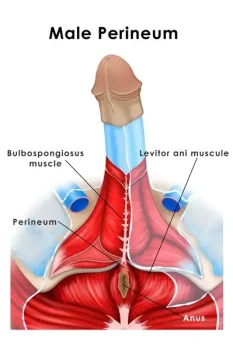
4. Prescription Medications
Certain medications can cause the penis to shrink in size. The medications include various forms of amphetamines generally prescribed for conditions such as attention deficit and hyperactivity disorder (ADHD), as well as certain antidepressants and antipsychotics, and medications prescribed for the treatment of an enlarged prostate.
Vasoconstriction is among the adverse effects of amphetamines.
Vasoconstriction is a phenomenon characterized by a reduction in blood flow due to the constriction of blood vessels. This may also be occurring in other areas of the body, but only the genital region is visibly affected. This is due to the fact that the penis consists solely of blood vessels to achieve and maintain its morphology. This effect may persist for up to a month. As an erection causes an increase in blood flow to the penis, the penis will return to its normal size once an erection is achieved. Also essential is the fact that these medications do not cause erectile dysfunction.
In addition to its interaction with the protein’s elastin and collagen, amphetamines can also cause a reduction in penile size. Adderall causes elastin to degrade. This causes a shortening of the ligament that attaches the base of the penis. This factor can cause the penis to diminish in both its flaccid and erect states.
Signaling pathways are a third reason why amphetamines may affect the size of the penis. This drug induces a cascade in the penis’ smooth muscle cells, resulting in their degradation. This physically reduces the actual bulk of the penis, resulting in a physical diminution of penis size.
A study published in the Journal of Sexual Medicine2 in 2012 revealed that a subset of male participants taking finasteride to treat an enlarged prostate reported reduced penis girth and sensation.
According to a 2014 study published in the journal Urology3, forty one percent of men taking dutasteride to treat an enlarged prostate experienced sexual dysfunction.
[2] Journal of Sexual Medicine: 2012 Nov;9(11):2927-32. doi: 10.1111/j.1743-6109.2012.
[3] Urology: 2014 Mar;83(3):539-43. Doi. 10.1016/j.urology.2013.
What is Chronic Penile Turtling?
Chronic penile turtling are treatable medical conditions in which a flaccid penis remains smaller than usual. As stated previously, it is completely typical for the size of a man’s flaccid penis to fluctuate multiple times per day for a variety of reasons. Such changes are normal and don’t require any sort of treatment.
However, what if your penis appears to constantly stay smaller when flaccid or if your non-erect measurement is notably shorter than it was in the past?
You might be suffering from some version of “clinical chronic penile turtling”. The good news is that all are fixable, but the solutions vary in terms of medical complexity.
There are numerous variations of “clinical turtling.” Most men want to clump them all into “whenever the penis shaft and glans are noticeably smaller in proportion to the scrotum.” However, it’s essential to determine which version you’re dealing with, as each variety requires a different approach to resolution.

The Five Leading Causes of Medical Penile Turtling

Following is a ranked list of the most frequent causes of chronic penile turtling, along with insights on how to clinically resolve each issue.
This ranking encompasses men of all ages. Nonetheless, some conditions are more prevalent in men over the age of 40. Additionally, males can experience more than one of these conditions simultaneously. We frequently encounter patients with more than one moderate condition that cumulatively causes persistent penile turtling. Their collective effects can be emotionally debilitating. In most cases, treating the most severe condition will restore a man’s flaccid penis to a more suitable size.
#5: Inadequate Arterial Flow
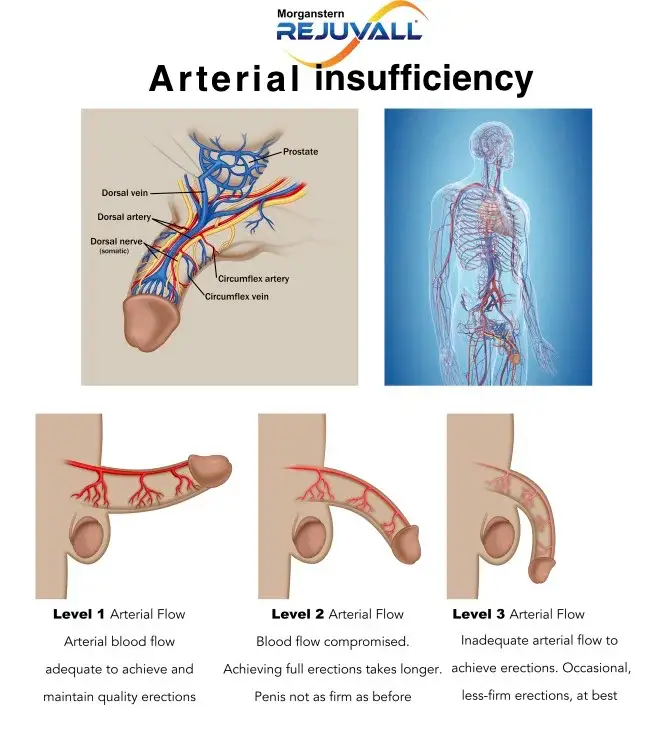
Inadequate arterial flow is most prevalent in men over the age of fifty, but it can occur at any age. It is also quite common in men with type 2 diabetes who have or have had an elevated A1C level near double digits at some point in their past. An elevated A1C causes arteries to shrink in diameter, thereby reducing the force and volume of blood flowing into the penis. Lowering your A1C will make the situation much better but it doesn’t naturally cause the body to regain the lost arterial diameter. Inadequate arterial flow is also a common side effect following surgery on the prostate.
As men age, the accumulation of fatty deposits in their arteries diminishes the blood flow force required for rapid erection.
This condition is also referred to as “arterial stiffness,” and it can contribute to the degeneration of muscle cells in the corpus cavernosa erectile tissue of the penis, as the erectile muscles require adequate blood saturation in order to generate erections. Vascular insufficiency also means there’s less blood available to support the penis at rest (when flaccid). Even a minor decline in penile vascular flow can affect flaccid size and trigger the appearance of chronic “turtling”.
Symptoms of arterial insufficiency
A notable slow down in the speed of getting an erection. Lack of complete penile engorgement during arousal. A noticeable reduction in flaccid penis size.
How is arterial insufficiency diagnosed?
Penile vascular health is diagnosed with a color duplex Doppler sonography test. Don’t let anyone con you by using a hand help Doppler testing unit. The readings from these inadequate and ancient devices only show the problem exists, they’re unable to help narrow in on the source of the problem.
DIY therapy for inadequate arterial flow
Mild arterial insufficiency is a medical condition where patients can improve their circumstances on their own.
Take Supplements: Taking blood flow supplement stimulators like L Arginine + L Citrulline are an affordable and easy way to help improve arterial flow.
Quit Smoking: Cigarette smoking and vaping are a common cause of arterial stiffness. Stopping or cutting down on smoking while help your circumstances.
Regular Exercise: Walking a couple of miles each day can dramatically improve your overall circulation which includes the blood flowing into your penis.
Buy a Penis pump: Twice weekly use of a vacuum erection device can help rehabilitate the blood flow and tissue within the penis.
Generic PDE5-Inhibitors: (sildenafil, vardenafil, tadalafil, and avanafil) Regular use of PDE5 inhibitors has shown4 to improve walking distance in patients with the peripheral arterial disease (PAD), likely through manipulating the Nitric oxide pathway. We usually recommend 5 mg of the “daily low dose” tadalafil to help improve blood flow within the penis.
Clinical Care for Arterial Insufficiency
In cases where arterial flow is deemed insufficient for erect penile performance, the only known “curative” therapy is at least 20 treatments on an external counterpulsation bed.
#4: Detached Dartos Fascia
[4] Pauls MM, Moynihan B, Barrick TR, Kruuse C, Madigan JB, Hainsworth AH, Isaacs JD. The effect of phosphodiesterase-5 inhibitors on cerebral blood flow in humans: A systematic review. J Cereb Blood Flow Metab. 2018 Feb;38(2):189-203.
The dartos fascia (or simply the “dartos”) is a thin, continuous muscle beneath the epidermis that connects the penile shaft to the scrotum within the pelvis. If a patient has suffered the effects of an engorged suprapubic fat pad (GEFP), they may experience the effects of dartos detachment.
A detached dartos fascia is the fourth most common source for chronic penile turtling.
Dartos detachment typically results from one of two causes. To begin with, the dartos is a muscle. As with any muscle, it will atrophy with age. Given that it is such a thin muscle membrane, it does not take much atrophy for it to separate. Secondly, and most frequently, GEFP (genetically engorged suprapubic fat pad) side effects can cause the muscle to separate due to the constant physical tension placed upon the tiny muscle from the enlarged pad.
How does a flaccid penis appear when the dartos has separated?

The term “grower vs. shower” is redefined by a penis with a detached dartos fascia. When flaccid, the penis retracts significantly into the body. In fact, the majority of men with a detached dartos fascia have about 80 percent of their penis located on the body’s interior when they are not aroused. When the penis of a man with detached dartos is flaccid, it resembles old socks sagging around your ankles after they’ve lost their elasticity.
DIY care for dartos detachment
Unfortunately, there are no “do it yourself” pathways available to improve matters following dartos detachment.
Clinical Care for Dartos Fascia Detachment
As previously stated, dartos detachment typically occurs because of muscle atrophy or from the pressure applied from a genetically predisposed engorged suprapubic fat pad.
In both instances, but especially in the latter, the reabsorption of tissue beginning at the penile shaft’s base poses an even greater danger. Once the dartos fascia detaches from the epidermis, destructive reabsorption commences. This clinical diagnosis leads to progressive reabsorption of the penile shaft, resulting in the loss of sexual function, diminished urologic function, and a significantly attenuated penis.
We cannot perform penile lengthening at the same time we repair dartos separation as we’ll need the deep ligaments as an anchor for urologic reconstruction. However, we can congruently perform a monsplasty (surgical removal of the suprapubic fat pad) when reconstructing the dartos fascia muscles, which usually equates to increased penile length for most patients.
What’s included in a dartos reconstruction and penile lengthening procedure?
1. We do not release the deep ligaments because we will need to use them as anchor points to attach the repaired dartos fascia when we raise and reposition the base of your penis to where it was prior to the degeneration caused by the disease.
2. The suspensory ligaments at the base of the penis are incised to aid with penile lengthening.
3. We surgically remove the fat tissue from the mons pubis, contour the area beneath the stomach to match the newly reduced fat pad area, and surgically tighten all surrounding skin.
4. This procedure restores the natural, healthy function of the penile structure while enhancing its length and appearance. Only conducting a mons pubis and/or ligament release without reconstructive urology to the dartos fascia will result in continuing penis shaft degeneration and eventual loss of critical penile functions.
A detached dartos should only be repaired through
surgery performed by a highly skilled reconstructive urologist.
#3: Overactive Sympathetic Nervous System
What’s the third most common reason men suffer from a perpetually shorter penis when flaccid? An overactive sympathetic nervous system most commonly occurring in men with anxiety disorders or high stress lifestyles.
The condition occurs from overactive triggering of the penile cremaster and dartos muscles. The penile cremaster muscles are a collection of small muscle fibers within the penile shaft that drop downward and envelop the testes and spermatic cord. The dartos muscle starts within the super pubic area and runs down under the epidermis down the shaft of the penis. It also helps connect and support the penis and its position relative to the scrotum.
As was discussed earlier, flaccid penis size is directly affected by contraction of the dartos and cremaster muscles during negative emotions such as anxiety and fear. Both of these muscles are activated by the body’s sympathetic nervous system.
This is why men who are shy about disrobing in front of others in a public dressing area (i.e. gym) will get smaller from the anxiety of that experience, adding to their angst.
Some men suffer from an overactive cremaster reflex, triggering a reduction in flaccid size with little or no stimuli.
DIY Treatment of Overactive Sympathetic Nervous System
Patients with anxiety disorders are among the most prone to suffer from chronic turtling. Patients should consider seeing a doctor to prescribe medications to help lower their anxiety levels.
Clinical Care for Overactive Cremaster Reflex
Men with an overactive cremaster reflex are most effectively treated with non-surgical application of dermal fillers sculpted within the penile shaft. As a result of the cremaster reflex, a flaccid penis naturally experiences a decrease in blood flow. However, the bulk and weight contributed by injected dermal agents will usually offset this reaction.
#2: Genetically Engorged Suprapubic Fat Pad
Lots of men face challenges related to a genetically inherited disorder in which the suprapubic fat pad, located immediately above the base of the penis, becomes overly swollen, leading to the concealment or partial coverage of a section of the penile shaft. This condition can pose significant challenges, especially when the patient experiences weight gain, although it can also manifest in individuals with a lean physique.
This condition is commonly referred to as “GEFP” and it’s the second most common reason men suffer from lost penile flaccid size.
What is a “GEFP”?
The term GEFP is an acronym for a genetically predisposed engorged suprapubic fat pad. What is the meaning of that? GEFP is a condition characterized by the presence of an enlarged suprapubic fat pad, the area situated in close proximity to the base of the penis.
The aforementioned ailment is most often a hereditary trait and results in a visual perception of reduced length and girth of the male genital organ, relative to its true dimensions. Weight gain frequently exacerbates the condition, however its root cause is attributed to genetic factors.
Many males experience feelings of humiliation and diminished self-assurance as a result of this phenomenon. Individuals with physiques characterized by “dad bodies” and robust builds, such as “linebacker bodies”, are frequently prone to experiencing the effects of GEFP due to the natural atrophy of muscle mass that occurs with aging. However, even individuals with slender body types are also susceptible to the condition.
The identification and postulation of GEFP have been attributed to both Kenneth J. Carney, MD, co-founder of Rejuvall, and several of the board-certified urologists who have received training under his GURS-urologic fellowship program. Indeed, a recent study on this topic was published by one of his proximate colleagues.
How does GEFP affect patients?
Your penis appears smaller
The penis is encompassed by an enlarged suprapubic pad, which may result in a perceived reduction in penile size, both when flaccid and erect.
The phenomenon is determined by hereditary factors.
Due to the fact that around 95% of cases of Genetically Engorged Fat Pad (GEFP) can be attributed to hereditary factors, it is possible for males of varying body types to have this condition.
The situation can be embarrassing
The issue of diminished penile dimensions might evoke feelings of embarrassment, whether one is in solitude before a bathroom mirror or in the presence of a new personal partner.
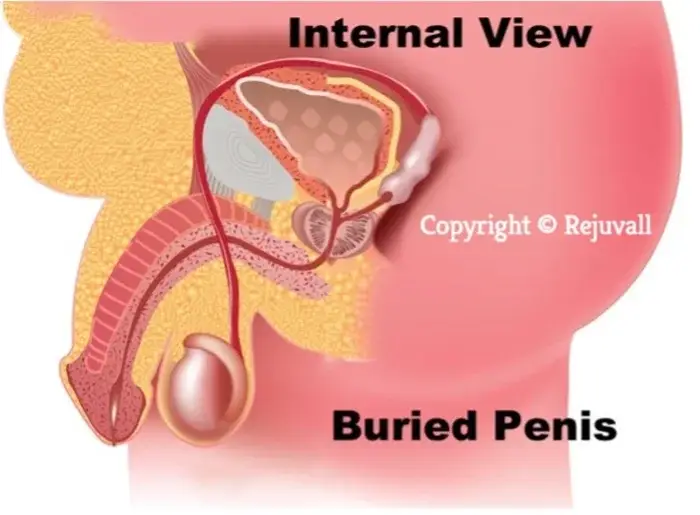
DIY Treatment: What would be the potential outcome if an individual were to lose weight?
The condition does not exhibit a direct correlation with an individual’s weight. Considering the predominantly hereditary nature of GEFP. Weight gain frequently exacerbates and intensifies the condition. Nevertheless, due to the genetic nature of the underlying issue, the enlargement of the suprapubic pad reaches a threshold beyond which substantial weight loss fails to diminish its dimensions.
Clinical Care for GEFP
Men with GEFP should be treated by an expert. Given that GEFP is a urologic condition, its resolution necessitates the expertise of a highly qualified urologist. If the etiology of the disease is attributed to weight gain, the amelioration of symptoms with the implementation of cosmetic interventions, such as liposuction or monsplasty, is frequently shown to yield temporary relief. The achievement of lasting results, wherein the shaft does not undergo reabsorption into the body over time, requires the use of a highly specialized set of skills within the field of urology.
World’s leading GEFP expert
Chief Medical Officer of Rejuvall, Kenneth J. Carney, MD PHARM FACS, is widely recognized as one of the most accomplished genitourinary reconstructive urologic surgeons in the world.
Dr. Carney is widely recognized as a leading authority in the field of reconstructive urology, specifically in relation to genitourinary reconstruction and major abdominal cases. As the founder and director of the sole fellowship program certified by the Genitourinary Reconstructive Surgeons (GURS), Dr. Carney is responsible for instructing other urologists who are already board-certified in the intricacies of Reconstructive and Plastic Urology.
#1: Bad, problematic, and imperfect neonatal circumcisions
What is the leading cause of chronic penile turtling in men?
Almost nobody gets this correct. The most frequent cause of chronic penile turtling is from a bad, problematic, or imperfect circumcision performed immediately following birth. The reason why flawed circumcisions are the number one cause of chronic penile turtling is a combination of their prevalence and the broad range of adverse effects that result from the different kinds of imperfect circumcisions.
What and why are circumcisions performed?
Circumcision is likely among the earliest surgical procedures. Circumcision was practiced by the Egyptians, as the earliest mummies discovered were circumcised. In the Jewish community, circumcision remains a religious rite and is typically performed by a Mohel on the eighth day of life.
Approximately one-sixth of the world’s male population is currently circumcised, primarily for religious reasons. In Western culture, circumcision is administered for medical reasons, phimosis being the most common. There is, however, a substantial difference between the circumcision rates in the United Kingdom (5.5%) and the United States (80-90 %).
The purpose of circumcision is to remove enough foreskin (penile shaft and interior preputial epithelium) to expose the glans.
Clinically speaking, there is an enormous difference between a “bad” “problematic” and “imperfect” circumcision. Studies show most complications are a result of a provider’s ineptitude as opposed to the employed method. The objective of each technique is to achieve the optimal cosmetic outcome with the lowest morbidity rate feasible.
Incident rates for bad, problematic, and imperfect circumcisions
The rate of adverse events varies widely across reports, depending on the definition chosen for a postoperative complication. Some authors have reported a complication rate as low as 0.065 percent, while others have quoted rates as high as 55 percent6. This reflects the use of diverse diagnostic criteria for what’s bad, problematic and imperfect.
Most studies in regards to problematic circumcisions focus on those classified as “bad”, since defining it is more clear-cut. Most often, a bad circumcision is addressed soon after birth. How often does that happen? A 2020 study7 revealed that during a five-year period at the Massachusetts General Hospital, 7.4% of all pediatric urologist consultations were for circumcision complications.
Clinically speaking, there is an enormous difference between a “bad” “problematic” and “imperfect” circumcision. Problematic and imperfect circumcisions are rarely considered for study since conditions such as reduced penile flaccid size are not considered any form of medical diagnosis.
Our own research at Rejuvall reveals circumcision imperfections could be a medically defined source for reduced penis size in up to 70% of all US men.
[5] Speert H. Circumcision of the newborn; an appraisal of the present status. Obstet Gynecol 1953; 2:164-72.
[6] Patel H. The problem of routine infant circumcision. Can Med Assoc J 1966; 95:576.
[7] Pieretti RV, Goldstein AM, Pieretti-Vanmarcke R. Late complications of newborn circumcision: a common and avoidable problem. Pediatric Surgery International. 2010;26(5):515–518
Neonatal Circumcisions: What can go wrong?
For purposes of this discussion, we’ll hypothesize that “bad circumcisions” were addressed soon after birth8. These include complications such as: bleeding, pain, inadequate skin removal, and surgical site infection. However, post circumcision bleeding in patients with coagulation disorders can be significant. Other serious early complications include chordee, iatrogenic hypospadias, glanular necrosis, and glanular amputation. Of course, most men who suffered consequences of these issues just after birth often have no idea the incident occurred as an adult male.
“Problematic circumcisions” are those recognized penile conditions that are addressed later in life. These include penile adhesions, webbed penis, epidermal inclusion cysts, suture sinus tracts, chordee, inadequate skin removal resulting in redundant foreskin, phimosis, buried penis, urethrocutaneous fistulae, meatitis, and meatal stenosis.
An “imperfect circumcision” include any version of circumcision including those listed above where the outcomes causes a measurable reduction in shaft skin mobility or skin deficiency. Our research shows up to 70% of US men suffer effects of reduced skin mobility and that condition affects both flaccid (very common) and erect (less common) penile size.
DIY treatment of bad, problematic, and imperfect circumcisions
There are no do-it-yourself remedies for improper, problematic, or defective newborn circumcisions. These issues will necessitate clinical care for patients to resolve.
[8] Pauls MM, Moynihan B, Barrick TR, Kruuse C, Madigan JB, Hainsworth AH, Isaacs JD. The effect of phosphodiesterase-5 inhibitors on cerebral blood flow in humans: A systematic review. J Cereb Blood Flow Metab. 2018 Feb;38(2):189-203.
Clinical care for bad, problematic, and imperfect circumcisions
The majority of issues caused by flawed neonatal circumcisions resulting in chronic penile turtling can be repaired via non-surgical procedures, and some can be performed in conjunction with other male enhancement procedures by a skilled, board-certified reconstructive urologist. Procedures performed by non-specialist doctors can exacerbate the condition.
Penile Turtling and its Resolution
Penile turtling occurs when a man’s flaccid penis becomes inordinately small and resembles the head of a turtle poking out of its shell.
Penile turtling is often a source of embarrassment to men when naked. It is acknowledged that the girth of a man’s flaccid penis plays a significant role in a man’s positive self-image. Each day, a man’s flaccid size varies in length and thickness. Changes in temperature and emotions along with use of certain prescription medications affect penis size throughout each day. In response to a signal from the body’s sympathetic nervous system, the cremaster and dartos muscles contract the penis, making it appear smaller.
Chronic penile turtling, in which the penis persists in a smaller state when flaccid, is not a natural condition and is associated with five distinct medical diagnoses that are all treatable with Rejuvall.
These include, in order of prevalence:
